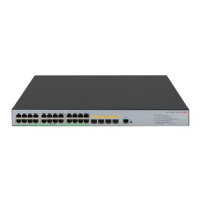5
• All hosts that have joined a multicast group become members of the multicast group. The group
memberships are dynamic. Hosts can join or leave multicast groups at any time. Multicast groups
are not subject to geographic restrictions.
• Routers or Layer 3 switches that support Layer 3 multicast are called "multicast routers" or "Layer 3
multicast devices". In addition to providing the multicast routing function, a multicast router can also
manage multicast group memberships on stub subnets with attached group members. A multicast
router itself can be a multicast group member.
For a better understanding of the multicast concept, you can compare multicast transmission to the
transmission of TV programs.
Table 1 Comparing TV program transmission and multicast transmission
TV transmission
Multicast transmission
A TV station transmits a TV program through a
channel.
A multicast source sends multicast data to a multicast
group.
A user tunes the TV set to the channel. A receiver joins the multicast group.
The user starts to watch the TV program transmitted
by the TV station via the channel.
The receiver starts to receive the multicast data that the
source is sending to the multicast group.
The user turns off the TV set or tunes to another
channel.
The receiver leaves the multicast group or joins another
group.
Common notations in multicast
The following notations are commonly used in multicast transmission:
• (*, G)—Indicates a rendezvous point tree (RPT), or a multicast packet that any multicast source sends
to multicast group G. Here, the asterisk represents any multicast source, and "G" represents a
specific multicast group.
• (S, G)—Indicates a shortest path tree (SPT), or a multicast packet that multicast source S sends to
multicast group G. Here, "S" represents a specific multicast source, and "G" represents a specific
multicast group.
For more information about the concepts RPT and SPT, see "Configuring PIM (available only on the
S5
500-EI)" and "Configuring IPv6 PIM (available only on the S5500-EI)."
Multicast advantages and applications
Multicast advantages
Advantages of the multicast technique include the following:
• Enhanced efficiency—Reduces the processor load of information source servers and network
devices.
• Optimal performance—Reduces redundant traffic.

